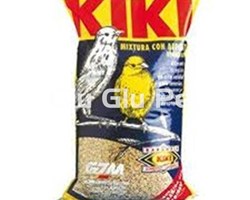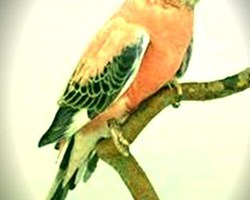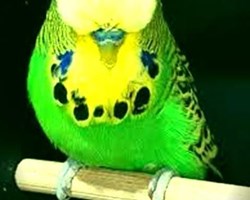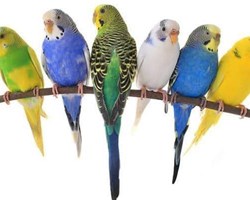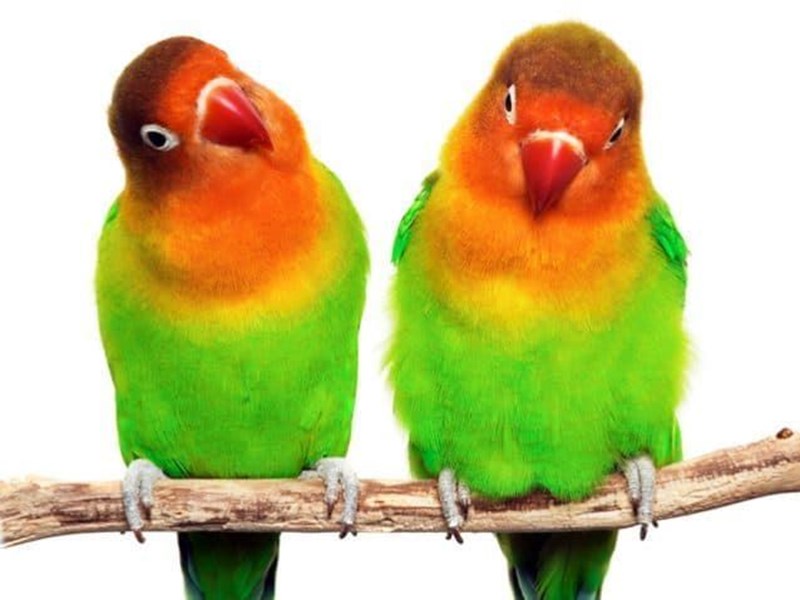
These colorful birds hide many curiosities that you may not know. Did you know that they are not as faithful as they seem?
Although the couple they choose is for life, they reproduce with other lovebirds.
The lovebird is an exotic bird of the parrot family from the African tropics.
It lives in sub-Saharan Africa, Tanzania, Kenya and Madagascar and can live between 10 and 15 years.
Its name comes from the Greek and means bird of love (agape - love; ornis - bird), a qualification derived from its monogamy and the strong bonds it establishes with its partner.
For the same reason it is also known as the inseparable or lovebird.
It is a small parrot with colorful feathers, a solid body and a height of between 13 and 16 centimeters depending on the species.
It has a strong beak and a lot of versatility in the legs, which it uses both for walking and for feeding.
Its tail is short and rounded and its plumage is very colorful, predominantly green and red or orange, although there are many mutations among which blue, violet or gray specimens can be found.
It is impossible to distinguish at first sight if a lovebird is male or female, since only 3 species present sexual dimorphism:
- Taranta.
- Cane.
- Pullarius, while to know the sex of the rest, a veterinary analysis or a DNA test is necessary.
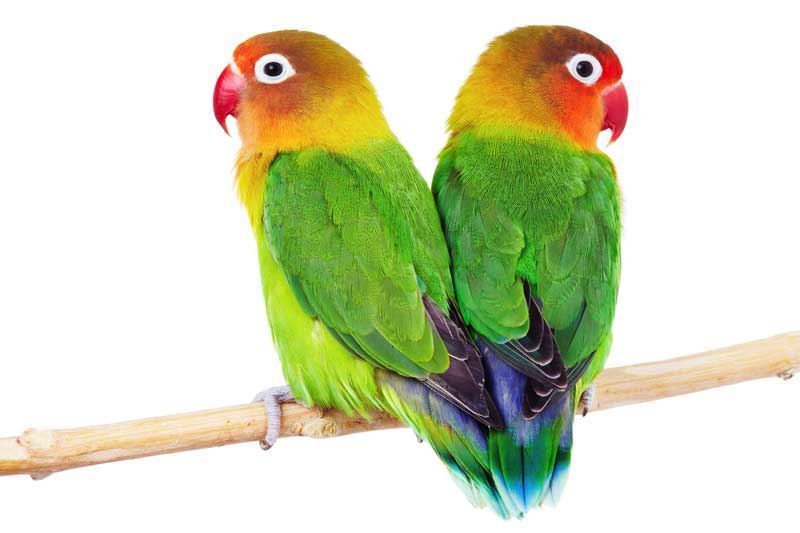
CURIOSITIES ABOUT THE AGAPORNIS:
- Unlike the sight of dogs, lovebirds have monocular vision, they can see from each eye independently without needing to use both eyes for full sight. In addition, his eyesight is very good despite how small he is.
- He doesn't like loneliness, so he will always be happier if he lives with a partner of the same species.
- When you notice that the lovebird does not stop moving, emits sounds incessantly, combs its plumage frequently and curiously observes everything around it, it is a very good sign. It means that he is happy, happy and in a very good mood.
On the other hand, if you see that he is not interacting, he is not sociable and he is not moving as usual, it means that he is sad. - What a lovebird likes most is to be snuggled up to its partner.
- He does not like to be stroked on his back, feathers or legs, it is better to do it on his head (the right area).
- Enjoy grooming your head and neck.
- Although they are the birds of love, they are not completely faithful to their partner since they can reproduce with other lovebirds and then return to their partner.
HOW CAN YOU GET THE TRUST OF A LOVEBIRD:
Many will see videos on the Internet where owners calmly carry their lovebirds on their shoulders or in their hands.
This is not something that can be achieved overnight.
It requires a lot of time of work and patience for the bird to gain trust with its owner.
At first it is best to keep a little distance.
The bird being locked in a cage, without having any freedom, will feel a little sad.
In addition, you will find yourself in an environment that you do not know, which will make you a little nervous. So, during the first days you have to avoid touching it or trying to catch it at all costs.
After a couple of days is when you have to start trying to gain the bird's trust.
For this, it is best that the cage is located in a room where there is a lot of social life, such as a living room or a dining room.
Little by little you have to approach the cage and pronounce its name, so that it gets used to the word.
But if you notice that the animal avoids contact, it is best to let it be.
Little by little the animal will approach the owner to recognize him.
But he won't be ready to be touched just yet.
There will come a time when the animal will not be scared to see its owner approaching the cage.
In that case you have to try to start feeding him directly from your hand, keeping the bed at all times.
At first the animal may be hesitant to approach, but gradually it will.
You may not get it the first time, but you will end up doing it.
When you get him to eat his "snacks" from your hand, it's time to start trying to get the lovebird to climb on your finger. To do this you have to lightly touch his abdomen, giving him a slight push to encourage him to get on.
It is possible that it goes down immediately, so at that moment you have to leave it be and try it again the next day.
Soon it will get used to climbing on your finger, and then it will be time to take it out of the cage with great care.
It is important that the room is closed, as it is not uncommon for the bird to try to go out and explore its surroundings.
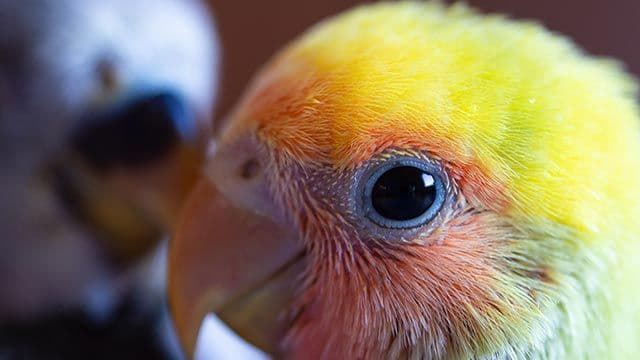
IT IS ADVISABLE TO LET THE LOVERS COME OUT OF ITS CAGE:
As with parakeets, there is no problem letting the lovebird out of the cage to have fun flying around the house. But this only has to be done when the bird has gained some confidence with its owner and with the rest of the people in the house.
You can let him fly around the house, but as long as all the windows are closed, although at first it is best to close the door of the room where the cage is located to avoid problems.
When the bird gets tired of exploring, it will return to its cage itself.
And if he doesn't, just put a little of his favorite snacks to make him do it.
There is no need to worry about hitting the furniture, since this is common when you do not know the room in which you are.
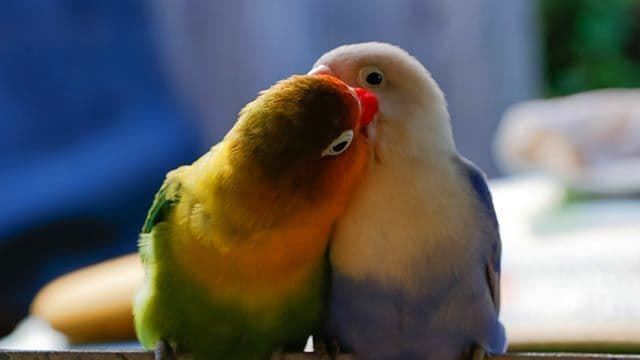
TYPES OF LOVERS:
Five of its members stand out for building their nests in the branches of trees, instead of nesting in cavities like most psittaciforms.
However, we can find 9 different species of lovebirds:
- Agapornis personata, Agapornis personatus or Black-headed Lovebird
- Agapornis lilianae or inseparable from the Nyasa.
- Agapornis nigrigenis or inseparable cheek.
- Agapornis swinderniana or inseparable collared.
- Fischer's lovebird, Agapornis fischeri or Fischer's lovebird.
- Agapornis canus or Malagasy lovebird.
- Agapornis pullarius or inseparable red-faced lovebird.
- Agapornis taranta or Abyssinian lovebird.
- Agapornis roseicollis or inseparable from Namibia.

HOW LOVE LOVERS SING:
They have an intense song but it is not noisy.
They can imitate sounds but it is difficult for them to learn to speak like other parrots.
Depending on the way it sings, we can know how our lovebird feels. Normally his sounds always indicate happiness and good humor, so if you hear him whistle and sing, you can be sure that he is totally happy!
On the other hand, you can do it for many hours at a time a day if you feel happy and calm.
And it can even ruffle its precious head feathers.
CARE OF THE AGAPORNIS:
The cage, the home of your lovebird, cannot be in any way.
You have to buy a cage that is of good quality, after all, it will be where the bird lives throughout its life.
Let's start with the size:
It is often said that "the bigger the better", but there is no reason to "go big".
For a couple, for example, the cage would have to be 1 meter long, 0.5 meters wide and 0.5 meters high.
So for the case in which there is going to be only one, it has to be a cage 0.5 meters long and 0.47 meters high and wide.
But the best thing is that it is one designed for two birds, because that way the lovebird has enough space to fly.
Also, the cages always have toys and other entertainment inside, so they end up getting small.
The shape of the cage is just as important as the size:
It should not be round, as this causes them insecurity as they do not have a point of reference with which to feel calm, since all the points of the cage are the same.
Nor does it have to be a house-shaped cage, since being made mostly of plastic, this makes it impossible for them to climb the walls.
So, the best option is a rectangular cage with horizontal bars so that they can grab with their feet or beaks.
The distance between the bars should not be more than 1.5 cm, thus preventing them from sticking their heads between them and dying of suffocation.
At least the cage must have two doors:
One so that they can be given water and food, while the other will be so that they have a nest outside if they were to dedicate themselves to breeding or so that the bird can go out to stretch its wings whenever it wishes.
Feeders are best filled from the outside, as filling from the inside can give them an escape route from the cage.
With water it would be the same, buying a plastic tube with which the animal can drink, especially in summer.
There are many debates about the bottom grid in lovebird cages.
It is true that if it does not exist, it is easier to clean, but it also makes these animals eat the food that has fallen on the ground, which may be contaminated by their feces, which is not recommended.
At the bottom of the cage you have to put something that allows it to be easy to clean, such as kitchen paper or newspaper, along with special soil for birds or crushed corn.
You should never use cat litter, since its absorption power could dry out the bird's crop, nor should you use scented paper.
Lovebirds are very active animals and need a lot of space to live comfortably.
Get him a very wide cage, at least 60 centimeters high and long, although the bigger the better.
Try to make it metal and the bars are horizontal so that it can climb.
Place perches of different thicknesses at different heights so that it can jump from one to another (it is 100% advisable to keep it active).
Also provide toys for entertainment and fun: ropes, swings or branches to peck at.
Something very important is that he does not like loneliness, so you should find him a partner so that he does not live alone.
But never put a mirror in the cage, since the animal can confuse its reflection with that of another lovebird and will try to interact.
To get them to live with a new tenant without problems, it is best to place them for the first few weeks in individual cages, one next to the other, so that they can see each other and get used to each other without fighting.
The biggest mistake most first-time owners make is filling the cage with a large number of toys, which actually leaves the animals with very little room to move around since the cage ends up being very crowded.
That's why you only have to buy a couple of toys, like a rope or a swing.
Unlike other birds, you can put a mirror on them, but it is not beneficial for the bird, since they are attracted to themselves, believing that they really have a partner in the cage and they will not want to separate from him.
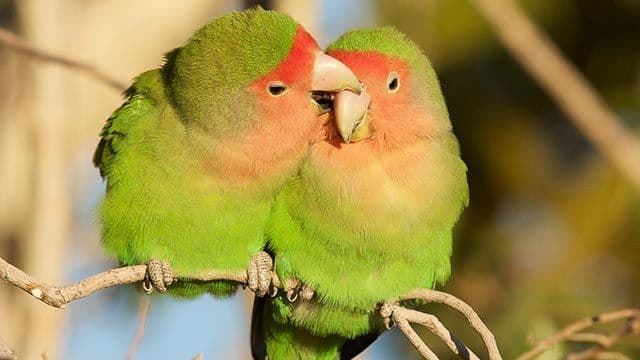
CLEANING OF THE CAGE AND THE AGAPORNIS:
Lovebirds are very clean birds, and you can see how every few minutes they are grooming their wings.
After all, they are quite flirtatious.
That is why they like to live in cages that are very clean.
Once a week, the cage must be completely disinfected, including the bars and toys, using a cloth (exclusively for this task) with warm water with a little diluted bleach.
Then you have to rinse it to avoid residues and dry it with a cloth or towel.
As for the bird, it is normal for him to clean his feathers alone, but you can put a large cup, or a large bowl, with water for him to take a bath and he will only wash himself.
He doesn't usually like being cleaned by humans, so it's better to let him do it himself.
SITUATION OF THE CAGE:
Because it has to be located in a place where there are no drafts, that is, it should not be near doors or windows or on balconies, as many mistakenly do.
The indicated place is that the cage is in a place where two parts of it are attached to the wall, which will give the bird a sense of security, that is free of smoke and lights that can directly affect it.
As for the strongest seasons of the year, avoid exposing it to extreme temperatures in summer and drafts in winter. It needs to live in a temperature between 18 and 25ºC.
For that reason, it is the ideal pet to live in our home.
Remember to always protect him from the cold by placing his cage in a dry place, free of drafts and preventing it from getting wet.
Feeding is also key to improving their plumage and protecting themselves in winter. Don't forget to provide calcium!
Finally, don't forget to provide him with a dish or a bathtub with water so that he can clean himself. And above all do not leave your drinker and feeder.
With optimal care, lovebirds can live up to 15 years.
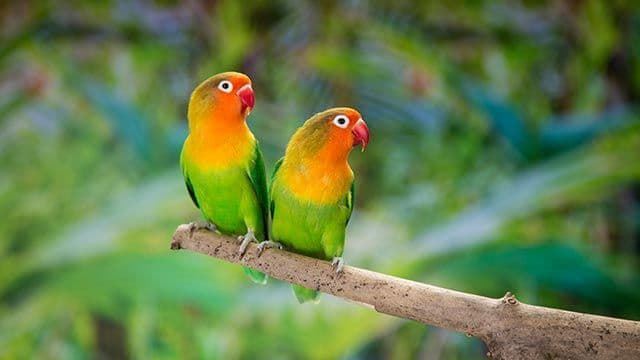
DISEASES THAT AN AGAPORNIS MAY HAVE:
Lovebirds are not disease-free.
Some can be deadly, but others, if caught early, can be cured in a few days.
- Respiratory acariasis: The bird breathes tired, scratches its throat and has ruffled feathers. As a general rule, it is due to mites that nest in the mucous membranes of the throat. It can be easily cured with some antibiotics.
- Cold: The common cold will make it difficult for him to breathe, he will emit mucous through his nostrils and will have ruffled feathers. If you have caught a cold, it is because you are in an area with strong drafts.
- Asthma: You will breathe heavily and feel down. This is because you are in an area of the house with too much humidity, or there are bacteria or fungi in your food. It is best to mix antibiotics with food so that it recovers.
- Dysentery: They will begin to pass soft stools, their movements will be rough, but with reluctance and they may aggressively peck food in the most severe cases. It can be caused by consuming food that is in poor condition or an excess of fruits or vegetables that are too ripe.
- Coccidiosis: The most common symptom is that your stools have blood due to some parasites that have infected you. In these cases, the cage and the food must be disinfected before they are going to eat them.
- Colibacillosis: They are not hungry and usually spend the day sleeping and anything makes them feel bad. It can be a deadly disease, so start antibiotics as soon as possible.
- Enteritis: You will not have an appetite due to intestinal inflammation, but you will be very thirsty. You will have some parasites in your body because of having eaten spoiled food or because of emotional stress. Give antibiotics with the water to help flush them out.
- Abnormal molt: Suddenly it will begin to have plucked body parts, with deformed and ruffled plumage. In these cases you have to give foods with many vitamins. It is usually common because they feel alone or have lost their sentimental partner.
- External parasites: Mites, lice or other types of parasites will be seen by the plumage. In these cases, you have to clean the cage well and give the bird a place to clean itself.
- Pneumonia: You will be breathing hard due to mucus in your nostrils. Like the cold, it is caused by having the cage located in an area with strong air currents. You have to give him antibiotics and vitamins to help him recover.
- Psittacosis: It is a rare disease today, of viral origin, but it sometimes occurs. There is no cure and it is also deadly for humans. The bird will be nervous, very sleepy, will not comment, will not drink and will have strong attacks of diarrhea.
- Bites: If there are many mosquitoes in the house, it will not be strange for the bird to have some bites. In these cases, some protectors must be placed in the cage to prevent the passage of mosquitoes. If the bird has been stung, apply a special ointment to the affected area.
- Salmonellosis: Although it will seem that it is skinny, its belly will be very swollen, its breathing will be labored, it will be very thirsty, but little desire to eat. Antibiotics and B vitamins must be given with food.
TRAINING OF THE LOVEBIRDS:
Some call, quite rightly, the lovebird "puppy with feathers".
It is not for less, since these animals are quite smart and they can be trained, with enough constancy in training, so that they can learn some other trick to teach the guests.
It will not speak as well as other parrots, but it is possible that when you call it it will come to you, take away the pencil with which you are writing or drink water from one of the glasses on the table.
It even climbs on the head to lovingly peck at it (some people feed them directly from it).
The training of this bird should begin at an early age, when they are about two or three months old, more or less.
It is the stage where you are most ready to learn something new.
However, there are a few things to keep in mind:
- Although it may be very interested in learning new tricks, it is possible that the bird will end up getting bored of doing the same thing over and over again, so if you notice that it has lost interest in the exercise, it is best to leave it alone.
- Every day you have to dedicate a couple of sessions to training, with a lot of patience, since at first it will be difficult for you to pay attention.
- You have to reward him whenever he has done something right with a snack or his favorite food. But to make it more “special” for you, it has to be something you eat only once in a while. A treat that you give him a couple of times a week at most, which will make him work twice as hard to eat it.
- When training begins, the room you train in should be locked, to prevent it from escaping through the window or door.
- Do not force him to do what he does not want. Even if he already has a bond with his owner, he may be a bit reluctant to try something new no matter how much it catches his eye.
- It is possible that he will peck you during the first days of training. In this case, you have to tell him "no" and put him back in the cage, so that he learns that this is not something he can do whenever he wants.
- Normally, the trick that is taught to this bird is to climb on the finger or go to eat from the hand. At first this has to be done inside the cage, but when the bird already has some confidence and allows itself to be taken out on the owner's finger, you can begin to try that the owner comes when he hears the name. At first you will have to be close to the cage, and then, little by little, lengthen the distance, so that he gets used to going as soon as he hears his name. If he succeeds, you have to reward him with the treat he likes the most.
Among other things, they can be taught to go to the table so that they can eat with the rest of the family or with the guests, even to do some little trick to capture the attention of those who are in the house.
Of course, under no circumstances should you take it by force, since this makes you lose confidence.
If he starts to fly over the room, you have to let him return to his cage.
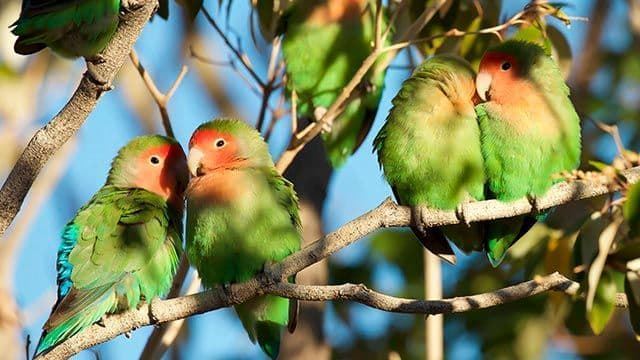
EVERYTHING YOU NEED TO KNOW TO TAKE CARE OF YOUR LOVEBIRDS:
It is important not to go overboard giving them treats, as they get fat easily.
You have to get them used to the fact that a kiss, a caress or a praise can also be a reward.
When trying to train it, it is important that the training sessions do not exceed 20 minutes, so that it does not get exhausted.
As long as he practices 20 minutes a day, he will be happy with the owner.
It is possible that if you try to feed him from your hand, he will peck you at first.
In this case, you don't have to move your hand away, since he will understand that his beak is his weapon and he could use it to attack.
When establishing a bond with the bird, such as touching it, you have to be calm, since they detect nervousness and this makes them nervous too.
You should never yell at a lovebird or hurt it, as this generates fear and mistrust.
It must spend at least 22 hours inside its cage, so that it does not get so used to the outside.
It's okay to let him out of it, but only to eat out of your hand or show him to friends when he's trained.
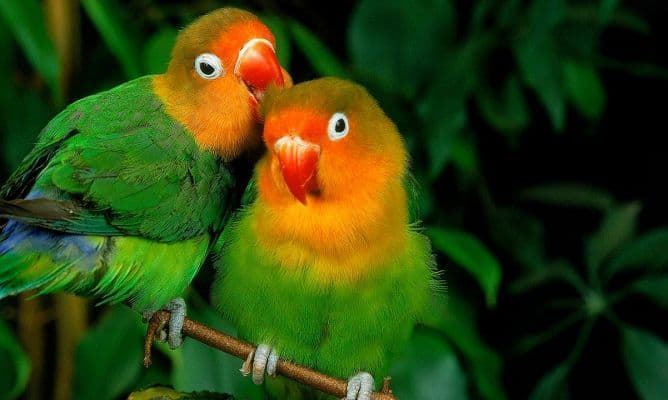
Other articles that might interest you:

